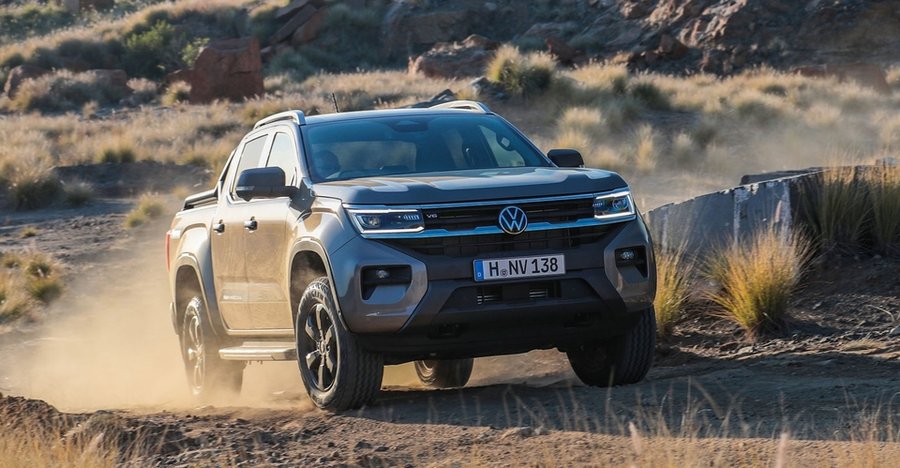2023 Volkswagen Amarok Revealed With Ford DNA And Nearly 300 HP

Developed from the ground up, the new Amarok has practically nothing in common with its predecessor of which more than 830,000 units have been sold since 2010. It eschews its Volkswagen bones to adopt Ford's updated T6 platform that has underpinned the latest Ranger. Mind you, it's more than just a rebadged version of the Blue Oval's midsize truck as VW has gone through great lengths to give the workhorse its own visual identity.
The new ute will be available upon launch in single cab and double cab body styles, with the latter stretching at 5,350 millimeters (210.6 inches). That makes it 96 mm (3.8 in) longer than the pickup it replaces and comes along with a 173-mm (6.8-in) extension of the wheelbase, now measuring a generous 3,270 mm (128.7 in). With the distance between the axles increasing more than the actual overall length, it means the overhangs have been shortened for better off-road capability by improving the approach and departure angles.
The width has decreased by 34 mm (1.4 in) to 1910 mm (75.2 in) while the height has increased by 10 mm (0.4 in) to 1888 mm (74.3 in), although that depends on the wheel and tire selection. Since we're on the subject of shoes, VW will sell the Amarok with standard 17-inch steel wheels, but the fancy ones will get a 21-inch alloy set for the first time.
Speaking of going off the beaten path, the 2023 Amarok's fording depth has been significantly boosted from 500 mm to 800 mm while all-wheel drive will be standard in many markets. Customers will get to pick from two 4Motion setups, one with selectable 4x4 and another with a permanent all-paw setup. Depending on the region, there will also be a cheaper entry-level variant with rear-wheel drive. Based on the engine choice, a towing capacity of up to 3,500 kilograms will be offered.
Four diesel engines and a gasoline mill have been prepared, all benefitting from turbocharging. In the African market, VW Commercial Vehicles will sell the new Amarok with a 2.0 TDI making 148 hp (110 kW) while other regions will get a more potent version of the oil-burner with 168 hp (125 kW). More expensive diesel-fueled Amaroks will rely on a bi-turbo four-pot setup with either 201 hp (150 kW) or 207 hp (154 kW).
The range-topping diesel engine will be a 3.0-liter V6 making 238 hp (177 kW) or 247 hp (184 kW). In regions where gasoline engines are preferred, the next-gen Amarok will boast a 2.3-liter unit producing 298 hp (222 kW). A ten-speed automatic transmission will be standard for all engines generating 207 hp (154 kW) or higher while the rest are going to be linked to a six-speed auto and a five- or six-speed manual.
VW is proud to say the maximum payload capacity has increased to 1,160 kg (2,557 lbs) while the roof can support a static load of 350 kg (772 lbs), enough for a four-person roof tent that will be available as an official accessory. The options list will once again include a hardtop cover for the cargo bed to give the Amarok the appearance of an SUV. From a bull bar to a snorkel, the truck gets a wide array of extras.
Not only has the exterior been completely revamped, but so has the cabin where the vertical infotainment takes center stage. Running on a mildly modified version of Ford's SYNC 4, the touchscreen measures 10 or 12 inches depending on the trim level. It sits alongside a digital instrument cluster with an eight-inch diagonal on the cheaper models and 12 inches for the upper trims.
VW aims to sell the 2023 Amarok in five different flavors: Amarok, Life, Style, and the newly added off-road-oriented PanAmericana along with a luxury-focused Aventura. Over 20 driver-assistance systems have been crammed into the truck, as well as matrix LED headlights and a Harman Kardon sound setup not offered on any other vehicle.
Ford will commence production of the all-new Amarok in September at its Silverton factory in Pretoria, South Africa. That said, VW Commercial Vehicles will continue to assemble the first-gen model in Pacheco, Argentina for South American regions.
Related News
